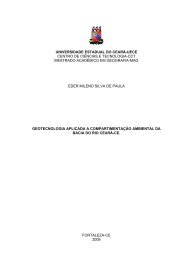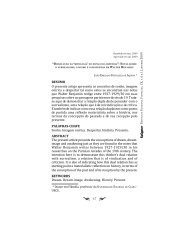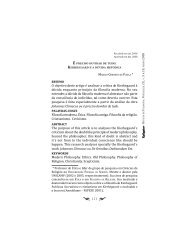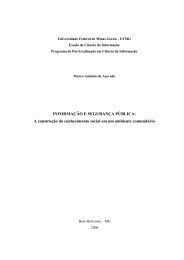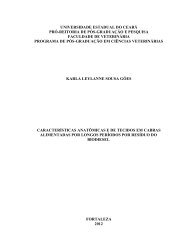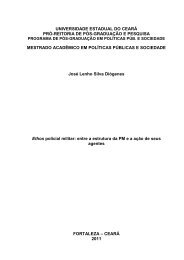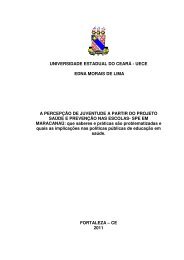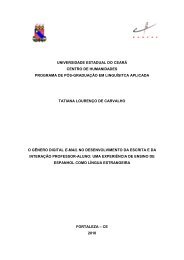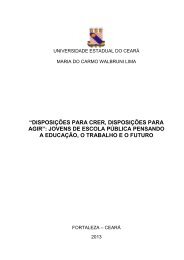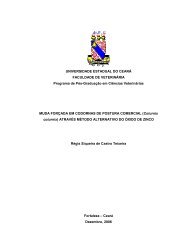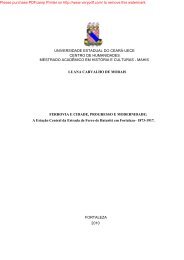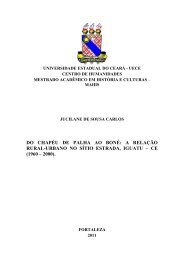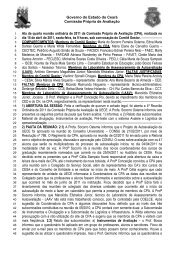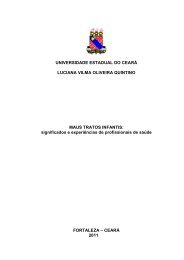Avaliação da temperatura, umidade e vacinação in ovo
Avaliação da temperatura, umidade e vacinação in ovo
Avaliação da temperatura, umidade e vacinação in ovo
You also want an ePaper? Increase the reach of your titles
YUMPU automatically turns print PDFs into web optimized ePapers that Google loves.
averaged 90% of egg lay<strong>in</strong>g production. All quails were supplied with balanced feed,<br />
water ad libitum and exposed to 17 hours/<strong>da</strong>y of light.<br />
Incubation<br />
The eggs were selected for <strong>in</strong>cubation verify<strong>in</strong>g egg shape, extreme sizes and<br />
eggshell <strong>in</strong>tegrity by candl<strong>in</strong>g. They were divided <strong>in</strong>to eight experimental groups<br />
accord<strong>in</strong>g to <strong>in</strong>cubation temperature. The eggs were <strong>in</strong>cubated at 34°C (n=100), 35°C<br />
(n=100), 36°C (n=100), 37°C (n=100), 38°C (n=100), 39°C (n=100), 40°C (n=100) and<br />
41°C (n=100). Each group of eggs was <strong>in</strong>cubated <strong>in</strong> a separated <strong>in</strong>cubator, accord<strong>in</strong>g to<br />
its experimental <strong>in</strong>cubation temperature. Incubation process was done by automatic<br />
<strong>in</strong>cubators with relative humidity of 60±5% and egg turn<strong>in</strong>g every 2 hours. At the 15 th<br />
<strong>da</strong>y of <strong>in</strong>cubation (360h) egg turn<strong>in</strong>g was stopped and the eggs were transferred to the<br />
hatcher which ma<strong>in</strong>ta<strong>in</strong>ed the same temperature and relative humidity until hatch.<br />
Weight measurement and Hatch<strong>in</strong>g Time<br />
All eggs were identified, <strong>in</strong>dividually, and weighed, by a precision balance<br />
(0.001g), on the first <strong>da</strong>y of <strong>in</strong>cubation. After transference, eggs were monitored to<br />
verify their hatch<strong>in</strong>g time every six hours. All quail chicks were weighed <strong>in</strong>dividually<br />
after hatch<strong>in</strong>g.<br />
Embryonic mortality<br />
Eggs that failed to hatch were opened for macroscopically observation, thus they<br />
were classified accord<strong>in</strong>g to time of embryonic mortality. They were staged as <strong>in</strong>fertile,<br />
early embryo death, <strong>in</strong>termediate embryo death, late embryo death and pipped eggs.<br />
This classification was similar to Pedroso et al. (2006) that classified the embryo<br />
mortality <strong>in</strong> quail as early death embryos (1 up to 4 <strong>da</strong>ys), <strong>in</strong>termediate (5 up to 15 <strong>da</strong>ys)<br />
and late death embryos (16 up to 18 <strong>da</strong>ys).<br />
Statistical Analysis<br />
Each experimental group (n=100) consisted of five replicates of 20 eggs. All<br />
<strong>da</strong>ta were analyzed us<strong>in</strong>g the Statistix software 8.0 (2003). The results were submitted<br />
the test of Shapiro-Wilk to verify normality and to Bartlett’s test to verify homogeneity<br />
of variances. Hatchability, chick/egg weight and hatch time means were submitted to<br />
Analysis of Variance through general l<strong>in</strong>ear model and the means were compared with<br />
35



